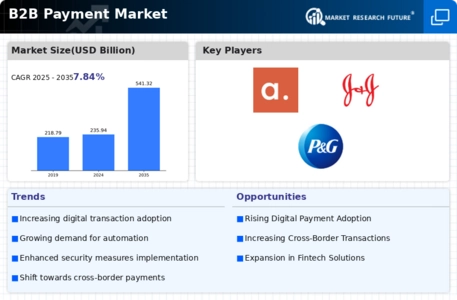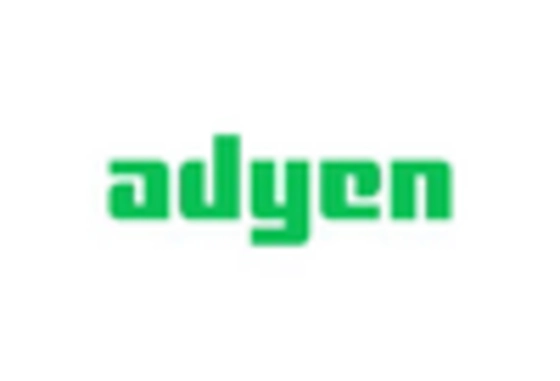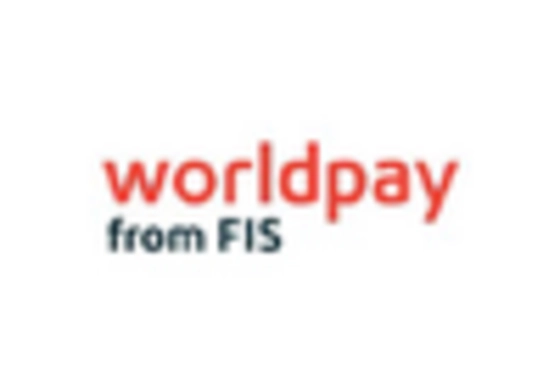Increased Focus on Payment Security
As cyber threats continue to evolve, the B2B Payment Market is witnessing an increased focus on payment security. Businesses are prioritizing the protection of sensitive financial data, leading to the adoption of advanced security measures such as encryption, tokenization, and multi-factor authentication. Recent studies indicate that 60% of businesses consider security a top priority when selecting payment solutions, reflecting a growing awareness of the risks associated with digital transactions. This heightened emphasis on security is likely to drive innovation within the industry, as payment providers strive to develop solutions that not only meet regulatory requirements but also exceed customer expectations. As a result, the B2B Payment Market is expected to see a surge in demand for secure payment solutions, which could potentially reshape the competitive landscape.
Regulatory Compliance and Standards
In the B2B Payment Market, regulatory compliance has emerged as a crucial driver, influencing how businesses manage their payment processes. With the introduction of stringent regulations aimed at combating fraud and ensuring data protection, companies are compelled to adopt compliant payment solutions. The implementation of standards such as the Payment Card Industry Data Security Standard (PCI DSS) is essential for maintaining customer trust and safeguarding sensitive information. Recent statistics indicate that non-compliance can lead to fines exceeding 2.5 million dollars, which underscores the financial implications of regulatory adherence. As businesses navigate this complex landscape, the demand for compliant payment solutions is expected to rise, thereby propelling growth within the B2B Payment Market. This focus on compliance not only mitigates risks but also enhances operational efficiency.
Emergence of Alternative Payment Methods
The B2B Payment Market is increasingly influenced by the emergence of alternative payment methods, which are gaining traction among businesses seeking flexibility and efficiency. Solutions such as digital wallets, cryptocurrencies, and buy-now-pay-later options are reshaping traditional payment paradigms. Recent data indicates that the use of digital wallets in B2B transactions is expected to grow by 25% annually, reflecting a shift towards more convenient payment options. These alternative methods not only enhance transaction speed but also cater to the diverse needs of businesses operating in various sectors. As companies seek to optimize their payment processes, the integration of alternative payment methods is likely to become a key driver of growth within the B2B Payment Market. This trend may also encourage traditional payment providers to innovate and adapt to changing consumer preferences.
Rise of E-commerce and Digital Marketplaces
The proliferation of e-commerce and digital marketplaces is significantly impacting the B2B Payment Market. As businesses increasingly engage in online transactions, the demand for efficient and secure payment solutions has surged. Recent data suggests that e-commerce sales in the B2B sector are projected to reach 6.7 trillion dollars by 2025, highlighting the immense potential for growth. This shift towards digital platforms necessitates the development of payment solutions that cater specifically to the unique needs of B2B transactions, such as bulk payments and invoicing. Consequently, payment providers are innovating to offer tailored solutions that enhance the user experience and streamline transaction processes. The rise of e-commerce not only drives demand for payment solutions but also fosters competition among providers, further stimulating advancements in the B2B Payment Market.
Technological Advancements in Payment Solutions
The B2B Payment Market is experiencing a notable transformation due to rapid technological advancements. Innovations such as blockchain, artificial intelligence, and machine learning are reshaping payment processes, enhancing efficiency and security. For instance, blockchain technology offers a decentralized ledger that can streamline cross-border transactions, reducing costs and time. According to recent data, the adoption of AI in payment processing is projected to increase by 30% over the next five years, indicating a shift towards more automated and intelligent systems. These advancements not only improve transaction speed but also bolster fraud detection capabilities, making the B2B Payment Market more resilient against cyber threats. As businesses increasingly seek to optimize their payment processes, the integration of these technologies is likely to become a critical driver of growth.

















Leave a Comment